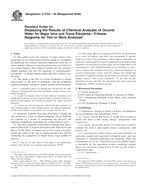Potrebujeme váš súhlas na využitie jednotlivých dát, aby sa vám okrem iného mohli ukazovať informácie týkajúce sa vašich záujmov. Súhlas udelíte kliknutím na tlačidlo „OK“.
ASTM D5754-95(2006)
Standard Guide for Displaying the Results of Chemical Analyses of Groundwater for Major Ions and Trace ElementsTrilinear Diagrams for Two or More Analyses (Withdrawn 2015)
Automaticky preložený názov:
Štandardné Sprievodca pre zobrazovanie výsledkov chemických analýz podzemných vôd pre hlavné iónov a stopových ElementsTrilinear Diagramy pre dvoch či viacerých analýz ( Withdrawn 2015 )
NORMA vydaná dňa 1.7.2006
Informácie o norme:
Označenie normy: ASTM D5754-95(2006)
Poznámka: NEPLATNÁ
Dátum vydania normy: 1.7.2006
Kód tovaru: NS-32398
Počet strán: 22
Približná hmotnosť: 66 g (0.15 libier)
Krajina: Americká technická norma
Kategória: Technické normy ASTM
Anotácia textu normy ASTM D5754-95(2006) :
Keywords:
chemical ions, geochemical classification, groundwater, hydrochemical facies, trilinear diagram, water analysis diagram: Carreno trilinear classification diagram, Chemical analysis--ground water, Chemical ions, D&apos,Amore classification diagram, Data analysis--soil/rock, Diamond diagram, Durov water-classification diagram, Filatov water chemistry, Furtak water type diagram, Gazda classification diagram, Geochemical classification, Ground water, Hill geochemical pattern, Hydrochemical facies
Doplňujúce informácie
| Significance and Use | ||||||
|
Many thousands of water samples are collected each year and the chemical components are determined from natural groundwater sources. A single analysis can be interpreted easily regarding composition and geochemical type; however, it is difficult to comprehend all of the factors of similarities, interrelationships, and differences when large numbers of analyses are being compared. One of the methods of interpreting the implication of these chemical components in the water is by displaying a number of related water analyses graphically on a visually summarizing water analysis diagram. The water analysis diagrams described in this guide display the percentages of the individual cation and anion weights of the total cation and anion weights on graphs shaped as triangles, squares, diamonds, and rectangles. Note 3—The concentration of dissolved solids determined for each analysis is not evident by the plotted location. Scaled symbols, usually circles, can represent the amount of dissolved solids for each analysis plotted on the diagrams. Classification of the composition of natural groundwater is a major use of water analysis diagrams. Note 4—Palmer (20) developed a tabular system for the classification of natural water. Hill (1) classified water by composition using two trilinear and one diamond-shaped diagrams of his own design combined. Back (21) improved the classification techniques for determining the hydrochemical facies of the groundwater by a modification of the Piper diagram. The origin of the water or degree of mixing may be postulated by examination of the placement and relationship of the cations and anions from different water samples that are plotted on the diagrams. Numerous interpretive methods are possible from the examination of water analysis diagrams. For example, it is reasonable to hypothesize the path that the groundwater has traveled while in the hydrologic regime, the amount of mixing that has occurred with water from a different origin, and the effects of ambient conditions, such as air, temperature, rock, and man-induced contaminants, on the water. Note 5—It should be noted that for many hydrochemical research problems involving the interpretation of the origin, chemical reactions, and mixing of natural water, the water analysis diagram is only one segment of several analytical methods necessary to understand the condition. |
||||||
| 1. Scope | ||||||
|
1.1 This guide covers the category of water analysis diagrams that use two-dimensional trilinear graphs as a technique for displaying the common chemical components from two or more complete analyses of natural groundwater (see Section 3) on a single diagram. This category includes not only trilinear-shaped diagrams but also the diamond- or parallelogram-, rectangular-, or square-shaped graphs that have trilinear subdivisions. 1.2 This guide is the first of several documents to inform professionals in the field of hydrology with the traditional graphical methods available to display groundwater chemistry. Note
1—Subsequent guides are planned that will describe the other
categories of diagrams that have been developed to display
groundwater chemical analyses. 1.3 Numerous methods have been developed to display the ions dissolved in water on trilinear diagrams. These diagrams are valuable as a means of interpreting the physical and chemical mechanisms controlling the composition of water. 1.4 The most commonly used trilinear methods were developed by Hill (1-3), Langelier and Ludwig (4), Piper (5, 6), and Durov (7-13). These techniques are proven systems for interpreting the origin of the ions in natural groundwater and for facilitating the comparison of results from a large number of analyses. Note 2—The use of trade names in this guide is for identification purposes only and does not constitute endorsement by ASTM. 1.5 This guide offers an organized collection of information or a series of options and does not recommend a specific course of action. This document cannot replace education or experience and should be used in conjunction with professional judgment. Not all aspects of this guide may be applicable in all circumstances. This ASTM standard is not intended to represent or replace the standard of care by which the adequacy of a given professional service must be judged, nor should this document be applied without consideration of a project's many unique aspects. The word “Standard” in the title of this document means only that the document has been approved through the ASTM consensus process. |
||||||
| 2. Referenced Documents | ||||||
|
Odporúčame:
Aktualizácia technických noriem
Chcete mať istotu, že používate len platné technické normy?
Ponúkame Vám riešenie, ktoré Vám zaistí mesačný prehľad o aktuálnosti noriem, ktoré používate.
Chcete vedieť viac informácií ? Pozrite sa na túto stránku.




 Cookies
Cookies
